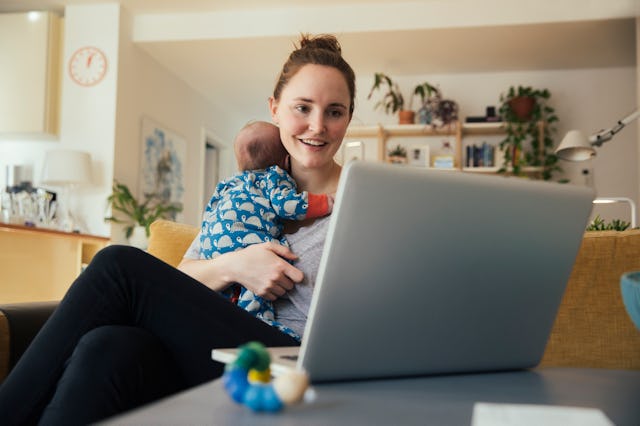Virtual Therapy Changed My Postpartum Life
I'm never going back to in-person.

Having a miscarriage and a fourth baby in the pandemic meant that I very clearly needed therapy. Ironically, because of the pandemic, I could actually go: virtual therapy opened up access to mental healthcare for many groups, including moms with no time and (hopefully) napping babies in the next room. For once, I could say yes to myself, and my own needs, by just jumping on a Zoom call. I have no plans to “return” to in-person therapy, and neither does any mom I know.
Turning to the convenience of telehealth to replenish
This wasn't my first experience with therapy, but the virtual option eliminated the logistical barriers that would have kept me from seeing a mental health specialist in person during the pandemic and beyond. I’m not alone — a 2021 report showed that one in four respondents had utilized telehealth services the month prior. Curious to know more, I reached out to Reena B. Patel, M.D., WHO says for moms with postpartum mental health concerns, both virtual therapy and apps connecting them to mental health support (such as Talk Space) have been vital in the pandemic. “You’re new parents, do you have the time to go out and seek support for yourself, or even be able to take a shower?” Instead of leaving for multiple hours to commute during rush hour, I was allotting just the 45 minutes needed to talk to the therapist in my own home.
With and without depression, she sees postpartum parents needing the rest a therapy session can virtually provide. “[Parents think] I’m going to give, give, give, and you’re depleted, but you don’t realize, ‘Wait, I need to refuel and reset,’” she says, explaining it gives parents the tools they need to overcome relationship and balance issues that can feel “daunting.” She says she often has to educate parents that neurochemical imbalances that are sometimes normal postpartum can cause people to feel “unhappy or down.” Therapy helps them return to themselves.
Though I didn’t officially have postpartum depression, losing a baby, trying to conceive for nearly a year, and navigating work-and-learn-from-home chaos, I’d had enough.
I was the furthest picture from every Instagram story I saw on self-care, struggling for work-life balance, and dealing with anxiety. One minute I was juggling quarantine schedules, work tasks, and homemade meals, and the next, I was breaking down over the clear probability that there was no way I could keep four children alive, healthy, and mentally well given the circumstances. Which was the plight of most pandemic mothers I knew.
Anytime relief for babysitting costs
After starting therapy via Zoom, I began to see almost immediate results, working with the therapist on mantras and digging into the why behind my 3 am Dr. Googling about SIDS, agitation at my inability to balance each aspect of my life, and self-blame over my own kid’s mental health concerns. And, as I paid just the copay for my visits, I realized that I was saving extra money every week that I would have had to give a babysitter just to leave for therapy.
Moms might not be going back to in-person therapy as well because therapists are now opening up appointments much beyond their old 9-5 hours. Patel says the flexibility extends to the therapists too, who can work virtually later in the evening.
Increased comfort, but sometimes at a cost
She’s also been able to work with clients who are “so depressed it’s harder to get out of bed.” Others are simply more at ease at home, especially those who have too much anxiety to be in public.
“You can be in your clothes that are comfortable. You can sit on the floor. You can sit wherever you want on the kitchen table. You can be with your child if you need to, while you’re nursing or even if your toddler is playing in the next room,” she says, noting that traditionally children aren’t allowed or able to accompany parents to in-person therapy.
But, like all perks of virtual life, there are downsides. “There are certain things that you cannot see that you might miss on screen sometimes,” Patel says, encouraging patients to keep their video on. “You have to be able to observe behaviors that are not verbally articulated.” Some examples of this include fidgeting, and evidence of self-harm or domestic abuse. Also, building a relationship with your therapist is a bit more disconnected than face to face, like anything else, so Patel hopes patients will consider a combination approach. “I think we’re human beings and we want that type of [in-person] connection as well, but virtual is definitely better than nothing.” And nothing is exactly what I would have been able to do, without the virtual mental health access that the pandemic necessitated, now and for the future.
Alexandra Frost is a Cincinnati-based freelance journalist, content marketing writer, copywriter, and editor focusing on health and wellness, parenting, real estate, business, education, and lifestyle. Away from the keyboard, Alex is also mom to her four sons under age 7, who keep things chaotic, fun, and interesting. For over a decade she has been helping publications and companies connect with readers and bring high-quality information and research to them in a relatable voice. She has been published in the Washington Post, Huffington Post, Glamour, Shape, Today's Parent, Reader's Digest, Parents, Women's Health, and Insider.
Alex has a Master of Arts in Teaching, and a Bachelor of Arts in Mass Communications/Journalism, both from Miami University. She has also taught high school for 10 years, specializing in media education. To read more of her work or to connect, check out her website or her social media on Twitter, Instagram, or Linked In.